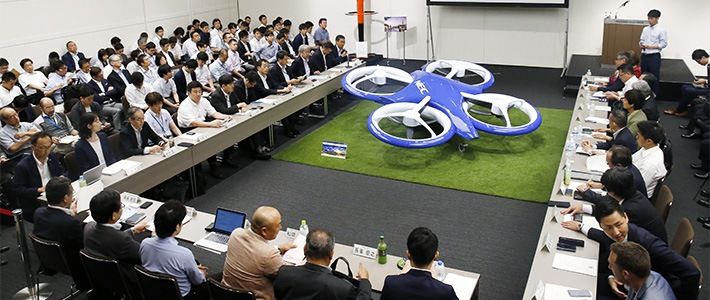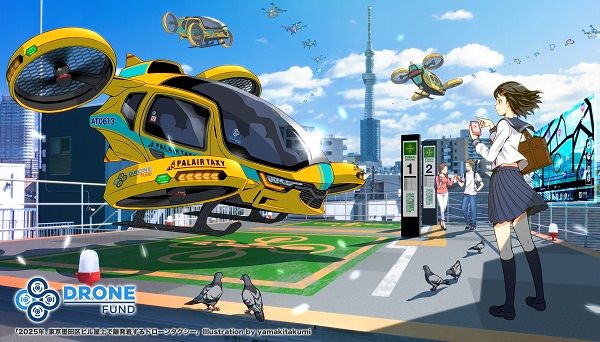
Japan Explores the Potential for Air Mobility
Technology Science- English
- 日本語
- 简体字
- 繁體字
- Français
- Español
- العربية
- Русский
The Sky’s the Limit
This year has seen a rush to propose new concepts for urban air transport. In May 2018, Uber Technologies announced that it would be making test runs of an airborne taxi service in Dallas and Los Angeles in 2020, with the objective of launching commercial service in 2023. In September, Airbus announced its Blueprint for Our Sky describing its vision for autonomous flight to transport goods and people. And in October, Boeing CEO Dennis Muilenburg announced that his firm’s air taxi prototype will be ready to fly in 2019.
Air mobility is expected to shorten travel time in urban settings, improve accessibility for outlying islands and mountainous areas, and expedite emergency transport of goods and people. In its Future Investment Strategy 2018, the Japanese government announced its plan to set up a government-industry council charged with drafting within the year a roadmap for the development of “flying vehicles.” Established in August, the Public-Private Conference for Future Air Mobility comprises government officials and representatives of corporations within and outside Japan, research organizations, and investment funds.
 An illustration from a joint press release on the air transport revolution shows a drone taxi stand atop a Tokyo high-rise building.
An illustration from a joint press release on the air transport revolution shows a drone taxi stand atop a Tokyo high-rise building.
The Technical Challenges of Autonomous Flight
While the term “air mobility” is not always clearly defined, for the purpose of this article I use it to refer to “airborne vehicles for shorter-distance flights.” Many of these kinds of vehicles now being developed are powered by electricity, in contrast to helicopters, for example, that are powered by piston engines and turboshaft engines. Those intended for people transport are close in size to a motorcycle or small car and designed to carry one to several passengers. Those for cargo transport are designed primarily to carry small to medium-sized parcels for home delivery.
There are two types of vehicles being developed. Horizontal landing aircraft with fixed-wing designs require a runway for takeoff and landing, while vertical takeoff and landing, or VTOL, aircraft feature single, multiple, or coaxial contrarotating rotors.
Factors that are key to developing real-life models are safety, efficiency, and low environmental impact.
Safety requires developing collision-avoidance mechanisms and control systems, establishing safety standards, clarifying emergency response methods, and drafting legal frameworks. Efficiency encompasses self-driving technology, vehicle maintenance using internet of things technology, and the like. There will also be a need to analyze flight data for research on developing effective traffic control systems. Regarding environmental impact, meanwhile, there is a need for measures to minimize noise and visual impact, as well as to promote the use of renewable energy.
The Benefits of a New Industry
Uber Technologies predicts that once air mobility is achieved it will be possible for electricity-powered VTOL vehicles to fly a 10-minute shuttle service between Tokyo and Yokohama.
In Japan it can take nearly an hour to get from a major airport to the center of the city it serves. And there are still places, such as the island of Shikoku, where there is no Shinkansen line, and people are forced to take roundabout routes to get to neighboring prefectures. It is hoped that using air mobility technology to link city centers with airports and high-speed rail stations will open up new sightseeing routes and facilitate the formation of industry clusters.
Air mobility could also become a major factor in carrying out emergency life-saving measures, supplementing helicopter ambulance services and search-and-rescue operations by police and firefighters in the public sector. Japan is always at risk for such large-scale disasters as earthquakes, tsunamis, and floods. Air mobility could become a powerful tool for enhancing public safety.
International Trends in Air Mobility
Globally, several approaches are being taken in air mobility research and development. Uber is focusing on building collaborative ties with partner corporations, government agencies, and local municipalities and on formulating urban air mobility concepts, applications, and platforms, while its “flying vehicles” are being developed by Bell Helicopter, Karem, Aurora Flight Sciences, Embraer, and Pipistrel Aircraft. Uber has also announced that it is working with NASA on traffic control systems. Uber is preparing to conduct test flights in the United States, and is in discussions on expanding its test flights to Japan, Australia, Brazil, and France.
Airbus and Boeing are taking full advantage of their strengths as aircraft makers. In January 2018, the Airbus A3 research program in Oregon successfully completed its first test flight of Vahana, an unmanned VTOL vehicle. Airbus has similar ongoing research projects around the world under such names as Pop.Up, City Airbus, and Skyways. Boeing, for its part, is beefing up its drone and air mobility technology by taking over Aurora Flight Sciences.
There are a number of startup companies emerging in the field as well. Ehang, a Chinese drone maker, unveiled its Ehang 184 at the Consumer Electronics Show held in Las Vegas in January 2016. The German company Volocopter exhibited its Volocopter 2X at the Frankfurt Motor Show held in September 2017. In California, a new company called Kitty Hawk is working on air mobility R&D with the financial backing of Alphabet CEO Larry Page.
In Japan, young volunteers from the automobile and aircraft industries and a number of start-up companies have formed a group called Cartivator to build a flying vehicle. Their activities are based in Aichi Prefecture and Tokyo. In July 2018, core members of the group established SkyDrive, an incorporated company headed by Fukuzawa Tomohiro and headquartered in the capital.
Air Mobility in Japan
The safety of aircraft and systems is of critical importance if air mobility is to take hold in society. This calls for enhanced designs and production technology, the development of batteries and other element technologies, environments conducive to carrying out test flights, the securing of funds and human resources, and the drafting of industry rules and regulations. Infrastructure will also be needed for traffic control systems and takeoff and landing sites. New traffic control systems need to be designed that incorporate both low- and high-altitude air use for the safety of conventional as well as automated airplanes. Finally, as regards takeoff and landing sites, consideration will need to be given to connections with other transportation systems, noise control, safety measures, and other factors related to overall urban design. Diverse efforts will be needed to incorporate air mobility and its required infrastructure into our current social systems.
(Originally published in Japanese on November 6, 2018. Banner photo: The first meeting of the Public-Private Conference for Future Air Mobility, in Tokyo in August 2018. © Jiji)